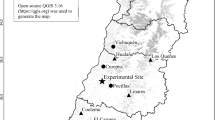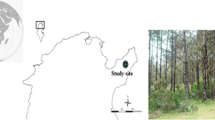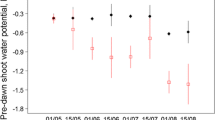Abstract
A study was conducted on the variation in growth, biomass, juvenile wood anatomy, and needle morphology of Pinus halepensis Mill. from three Spanish regions of provenance characterized by environmental differences, without the influence of the site factor. Seeds collected from two progenies in each region were planted in a single plot, and the trees were felled at the age of 7 years. The results showed significant differences between provenances, as well as the genetic or environmental influence on the traits analyzed. Trees adapted to moderate summer drought conditions (Inland Catalonia region) are primarily characterized by higher average values for height, diameter, biomass, cell wall thickness, inter-tracheid wall strength, pit membrane diameter, torus diameter, bordered pit aperture diameter, and ray tracheid abundance in comparison with trees adapted to severe summer drought conditions (Southern region and Balearic Islands region). The greater structural requirements of trees from the Inland Catalonia region, subjected to higher weight and wind loads, resulted in thick cell walls. Moreover, the large pits and more abundant ray tracheids in trees from this provenance would allow more efficient water transport and greater water storage capacity, respectively. The differences found between provenances suggest the adaptive nature of the anatomy of this species, which demonstrates the importance of the region of provenance when choosing reproduction material for reforestation.




Similar content being viewed by others
References
Aguilar-Rodríguez S, Terrazas T, López-Mata L (2006) Anatomical wood variation of Buddleja cordata (Buddlejaceae) along its natural range in Mexico. Trees Struct Funct 20:253–261
Canny MJ (1993) Transfusion tissue of pine needles as a site of retrieval of solutes from the transpiration stream. New Phytol 123:227–232
Castellarnau JM (1883) Estudio micrográfico del sistema leñoso de las coníferas y en general del Género Pinus. Anales de la Sociedad Española de Historia Natural XII:136–219
Chave J, Coomes D, Jansen S, Lewis SL, Swenson NG, Zanne AE (2009) Towards a worldwide wood economics spectrum. Ecol Lett 12:351–366
Choat B, Cobb AR, Jansen S (2007) Structure and function of bordered pits: new discoveries and impacts on whole-plant hydraulic function. New Phytol 177:608–626
Chudnyi AV (1974) The importance of investigating the resin-duct system in Scots pine wood in selection for resin productivity. Genetika selektsiya, semenovodstvo i introduktsiya lesnykh porod, Moscow
Climent J, Chambel MR, Perez E, Gil L, Pardos J (2002) Relationship between heartwood radius and early radial growth, tree age, and climate in Pinus canariensis. Can J For Res 32:103–111
Climent J, Prada MA, Calama R, Chambel MR, De Ron DS, Alia R (2008) To grow or to seed: Ecotypic variation in reproductive allocation and cone production by young female Aleppo pine (Pinus halepensis, Pinaceae). Am J Bot 95:833–842
Cochard H, Casèlla E, Mencuccini M (2007) Xylem vulnerability to cavitation varies among poplar and willow clones and correlates with yield. Tree Physiol 27:1761–1767
De Palacios P (1997) Anatomía de maderas de coníferas a nivel de especie. Región norteamericana y europea, PhD thesis. Universidad Politécnica de Madrid, Escuela Técnica Superior de Ingenieros de Montes, Madrid
Domec JC, Gartner BL (2002) How do water transport and water storage differ in coniferous earlywood and latewood? J Exp Bot 53:2369–2379
Esteban LG, Guindeo A (1988) Anatomía e identificación de maderas de coníferas españolas. AITIM, Madrid
Esteban LG, de Palacios P, Guindeo A, García L, Lázaro I, González L, Rodríguez Y, García F, Bobadilla I, Camacho A (2002) Anatomy and identification of conifers wood as a species. Fundación Conde del Valle de Salazar-Mundi-Prensa, Madrid
Esteban LG, de Palacios P, Guindeo A, García Fernández F (2007) Comparative anatomy of the wood of Abies pinsapo and its two Moroccan varieties. IAWA J 28(3):285–299
Ezquerra FJ, Gil L (2001) Wood anatomy and stress distribution in the stem of Pinus pinaster Ait. Invest Agrar Sist Recur For 10:165–177
Fahn A, Zamski E (1970) The influence of pressure, wind, wounding and growth substances on the rate of resin duct formation in Pinus halepensis wood. Israel J Bot 19:429–446
Fernández M, Gil L, Pardos JA (1999) Response of Pinus pinaster Ait. provenances at early age to water supply. I. Water relation parameters. Ann For Sci 56:179–187
Gil L, Díaz-Fernández PM, Jiménez MP, Roldán M, Alia R, Agúndez D, de Miguel J, de Tuero M (1996) Las Regiones de Procedencia de Pinus halepensis Mill. en España. Organismo Autónomo Parques Nacionales, Madrid
Gil L, López R, García-Mateos A, González-Doncel I (2009) Seed provenance and fire-related reproductive traits of Pinus pinaster Ait. in Central Spain. Int J Wildland Fire (in press)
Gómez A, Alia R, Bueno MA (2001) Genetic diversity of Pinus halepensis Mill. populations detected by RAPD loci. Ann For Sci 58:869–875
González-Martínez SC, Gerber S, Cervera MT, Martínez-Zapater JM, Gil L, Alía R (2002) Seed gene flow and fine-scale structure in a Mediterranean pine (Pinus pinaster Ait.) using nuclear microsatellite markers. Theor Appl Genet 104:1290–1297
Gratani L, Bombelli A (2000) Correlation between leaf age and other leaf traits in three Mediterranean maquis shrub species: Quercus ilex, Phillyrea latifolia and Cistus incanus. Environ Exp Bot 43:141–153
Hacke UG, Sperry JS, Pockman WT, Davis SD, McCulloh K (2001) Trends in wood density and structure are linked to prevention of xylem implosion by negative pressure. Oecologia 126:457–461
Hacke UG, Sperry JS, Pittermann J (2004) Analysis of circular bordered pit function. II. Gymnosperm tracheids with torus-margo pit membranes. Am J Bot 9:386–400
IAWA Committee (2004) IAWA list of microscopic features for softwood identification. IAWA J 25(1):1–70
Jagels R, Visscher GE (2006) A synchronous increase in hydraulic conductive capacity and mechanical support in conifers with relatively uniform xylem structure. Am J Bot 93:179–187
Jagels R, Visscher GE, Lucas J, Goodell B (2003) Paleo-adaptive properties of the xylem of Metasequoia: mechanical/hydraulic compromises. Ann Bot Lond 92:79–88
Jane FW (1970) The structure of wood, 2nd edn. A & C Black, London
Johansen DA (1940) Plant microtechnique. McGraw-Hill, New York
Kolb KJ, Sperry JS (1999) Differences in drought adaptation between subspecies of sagebrush (Artemisia tridentata). Ecology 80:2373–2384
Ladell JT (1959) A new method of measuring tracheid length. Forestry 32:124–125
Le Houerou N (1980) L’impact de l’homme et de ses animaux sur la forêt méditerranéenne. Forêts méditerranéennes II(I):31–34
López R, Climent J, Gil L (2008) From desert to cloud forest: the non-trivial phenotypic variation of Canary Island pine needles. Trees Struct Funct 22:843–849
Maldonado F, Sainz Ollero H, Sánchez de Dios R (1998) Distribución y estado de los bosques en España. UAM-WWF, Madrid
Mayr S, Cochard H (2003) A new method for vulnerability analysis of small xylem areas reveals that compression wood of Norway spruce has lower hydraulic safety than opposite wood. Plant Cell Environ 26:1365–1371
Mayr S, Wolfschwenger M, Bauer H (2002) Winter-drought induced embolism in Norway spruce (Picea abies) at the Alpine timberline. Physiol Plantarum 115:74–80
McCullagh P, Nelder JA (1989) Generalized linear models. Chapmann and Hall, London
Mencuccini M, Grace J, Fioravanti M (1997) Biomechanical and hydraulic determinants of tree structure in Scots pine: anatomical characteristics. Tree Physiol 17:105–113
Ortuño F, Ceballos A (1977) Los Bosques Españoles. INCAFO, Madrid
Paula S, Pausas JG (2006) Leaf traits and resprouting ability in the Mediterranean basin. Funct Ecol 20:941–947
Peraza C (1964) Estudio de las Maderas de Coníferas Españolas y de la Zona Norte de Marruecos. IFIE, Madrid
Pickard W (2008) Laticifers and secretory ducts: two other tube systems in plants. New Phytol 177:877–888
Pittermann J, Sperry JS, Hacke UG, Wheeler JK, Sikkema EH (2006) Inter-tracheid pitting and the hydraulic efficiency of conifer wood: the role of tracheid allometry and cavitation protection. Am J Bot 93:1265–1273
Rigling A, Brühlhart H, Bräker OU, Foster T, Schweingruber FH (2003) Effects of irrigation on diameter growth and vertical resin duct production in Pinus sylvestris L. on dry sites in the central Alps, Switzerland. For Ecol Manage 175:285–296
Rosner S, Klein A, Müller U, Karlsson B (2007) Hydraulic and mechanical properties of young Norway spruce clones related to growth and wood structure. Tree Physiol 27:1165–1178
Royo A, Gil L, Pardos JA (2001) Effect of water stress conditioning on morphology, physiology and field performance of Pinus halepensis Mill. seedlings. New For 21:127–140
Schiller G, Gonkle MT, Grunwald C (1986) Local differentiation among Mediterranean populations of Aleppo pine in their isoenzymes. Silvae Genet 35(1):11–19
Spatz HC, Bruechert F (2000) Basic biomechanics of self-supporting plants: wind loads and gravitational loads on a Norway spruce tree. For Ecol Manage 135:33–44
Sperry JS, Tyree MT (1990) Water-stress-induced xylem embolism in three species of conifers. Plant Cell Environ 13:427–436
Sperry JS, Hacke UG, Pittermann J (2006) Size and function in conifer tracheids and angiosperm vessels. Am J Bot 93:1490–1500
Spicer R, Gartner BL (1998) Hydraulic properties of Douglas-fir (Pseudotsuga menziesii) branches and branch halves with references to compression wood. Tree Physiol 18:777–784
Tyree MT, Davis SD, Cochard H (1994) Biophysical perspectives of xylem evolution: is there a tradeoff of hydraulic efficiency for vulnerability to dysfunction? IAWA J 15:335–360
Voltas J, Chambel M, Prada M, Ferrio J (2008) Climate-related variability in carbon and oxygen stable isotopes among populations of Aleppo pine grown in common-garden tests. Trees Struct Funct 22:759–769
Weinstein A (1989) Geographic variation and phenology of Pinus halepensis, P. brutia and P. eldarica. Israel. For Ecol Manage 26:215–225
Woodward S (1992) Responses of gymnosperm bark tissues to fungal infections. In: Blanchette A, Biggs R (eds) Defense mechanisms of woody plants against fungi. Springer, Berlin, pp 62–75
Young WC (1989) Roark’s formulas for stress and strain. McGraw Hill, New York
Zobel BJ, van Buijtenen JP (1989) The effect of provenance variation and exotic plantations on wood properties. In: Timell TE (ed) Wood variation. Springer, Berlin, pp 33–71
Acknowledgments
The authors are grateful to the following for their assistance: Prof. Luis Gil (Universidad Politécnica de Madrid), for reviewing the manuscript, making suggestions and providing a critique; Beatriz Becerril (Universidad Politécnica de Madrid), for assistance in preparing the microscopic slides; and Dr. José María Climent (CIFOR-INIA, Madrid), for providing the samples which made this study possible.
Author information
Authors and Affiliations
Corresponding author
Additional information
Communicated by H. Cochard.
L. G. Esteban and J. A. Martín contributed equally to this work.
Rights and permissions
About this article
Cite this article
Esteban, L.G., Martín, J.A., de Palacios, P. et al. Adaptive anatomy of Pinus halepensis trees from different Mediterranean environments in Spain. Trees 24, 19–30 (2010). https://doi.org/10.1007/s00468-009-0375-3
Received:
Revised:
Accepted:
Published:
Issue Date:
DOI: https://doi.org/10.1007/s00468-009-0375-3




